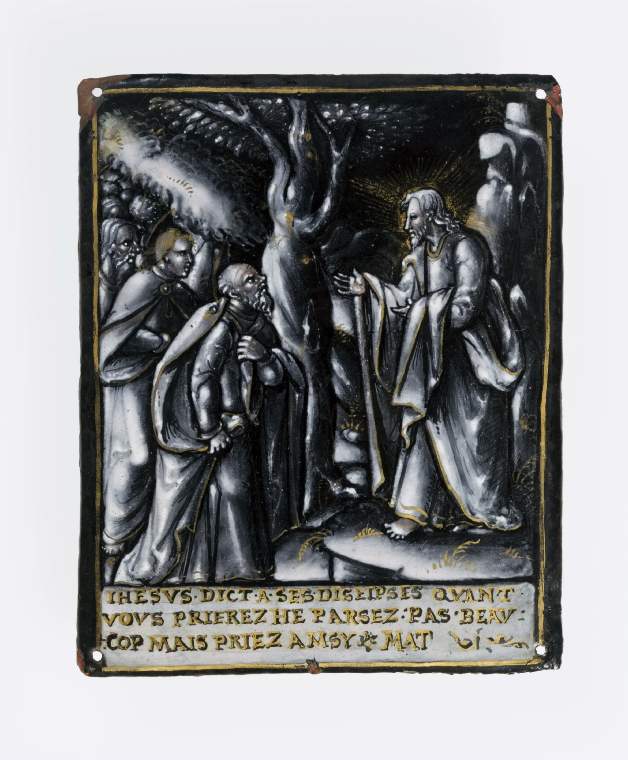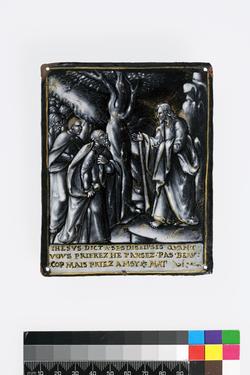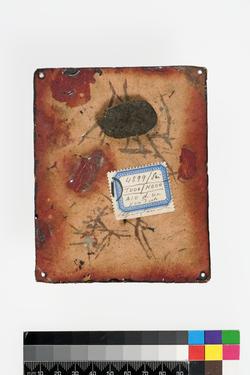Current Location: In storage
Titles
The Lord's Prayer I: Christ teaching the Disciples how to Pray
Maker(s)
Maker:
Nouailher, Colin
Holbein, Hans, the younger
(After)
Printmaker:
Monogrammist C. V.
(After)
Entities
Categories
Description
Rectangular copper plaque enamelled en grisaille with a little flesh pink and red on a black ground, and gilded. Christ teaching the disciples how to pray, inscribed below, 'IHESVS• DICT•A•SES•DISEIPSIES QVANT/VOVS PRIEREZ HE PARSEZ: PAS•BEAV:/COP MAIS PRIEZ AMSY (sprig) MAT V'1. One of a set with M.49B-F-1904
Rectangular copper convex plaque with a small hole in each corner, enamelled in grisaille with a little flesh pink on a black round, and gilded. Clear, unevenly applied clear counter-enamel. Christ stands on a flat rock on the right addressing his disciples who stand slightly below him in a group on the left. He is barefooted, and has a gold aureole, long hair, and a beard, and wears a long gown with a cloak over it. The first disciple on the left, probably St Peter, is old and bearded, and wears a long gown with a cloak which he holds up in his right hand and clutches to his chest with his left hand. The disciple behind him, probably St John, is younger and clean-shaven with golden hair, and wears a long gown and cloak fastened together over his chest with a brooch. The head of another disciple is shown behind him, but only the tops of the heads of the rest of the group behind them are shown. A large tree stands in the background between Christ and the disciples. Gold lines run round the edges of their clothing, and there are small gold plants on the rock and beyond the tree, which is entwined by a delicate gold vine.
A white panel running across the bottom of the plaque is inscribed in black with gilding over it ‘IHESVS• DICT•A•SES•DISEIPSIES QVANT/VOVS PRIEREZ HE PARSEZ: PAS•BEAV:/COP MAIS PRIEZ AMSY (sprig) MAT V1’ (Jesus said to his disciples ‘When you pray do not speak too much but pray thus’ Matthew V1) . A gold line runs round the edge of the scene and inscription. The reverse is painted in black with the number ‘1’.
The plaque is set in an ill-fitting, rectangular, gilt-metal frame with repeating formal leaf border. The plaque is held into the frame by four bent over pins attached to the cardinal points on the reverse.
Notes
History note: Uncertain; possibly Robert Napier, West Shandon, Dunbartonshire by 1865; sold Christie’s, 5 June, 1877, part of lot 2594; sold to Stettiner (probably Henri). An unidentified French sale in which the six plaques formed lot 289. An unidentified Italian owner or dealer before or after the sale. Frank McClean MA, FRS (1837–1904), Rusthall House, near Tunbridge Wells
Legal notes
Frank McClean Bequest
Acquisition and important dates
Method of acquisition: Bequeathed
(1904)
by
McClean, Frank
Dating
16th Century, Mid
Circa
1540
CE
-
1550
CE
Note
This plaque was originally the first of a set of eight illustrating the Lord's Prayer of which six are in the Fitzwilliam (M.49A-F-1904). The second and fourth plaques are missing. The first plaque shows Christ instructing his disciples how to pray (Matthew, VI, 6-7), and the others have scenes associated with the lines of the Lord's Prayer which follows (Matthew, VI, 8-13). The words are written in French at the bottom of each plaque. The subject of the first plaque is shown out-of-doors, because this passage in the Gospel forms part of the Sermon on the Mount.
So far no documentary evidence for the use of the plaques has been found. However, it seems likely that framed sets could have been used as teaching aids. Their production needs to be viewed in the context of efforts by evangelical Protestant and Gallican Catholic reformers to improve the religious education of the clergy and laity. Learning to repeat and understand the Lord's Prayer was a fundamental aspect of Christian education. The publication of Luther’s commentaries on the Creed and Lord’s Prayer in 1518 and 1519 inspired a spate of comparable works, ranging from learned works for scholars to simple pamphlets with the Lord's Prayer, Creed, and Hail Mary printed in Latin and French for the laity.
The scenes on the enamelled Lord's Prayer plaques were derived from a set of metalcuts by the Basel monogrammist C.V. after Holbein which appeared in Desiderio Erasmus's 'Precatio dominica in septem portiones', published by both Johann Froben and Johannes Bebel successively in Basle in 1524. The work was first published without illustrations in 1523, and was rapidly translated into modern languages. The illustrations in the Froben and Bebel editions have the inscriptions in Latin, but a set of eight prints issued separately a little later with inscriptions in French, signed CV, is in the British Museum (1904,0206. 64.1-8;) and seven of the set (no. 4 is missing) are in the Cabinet des Estampes, Bibliothèque nationale, Paris (EA 25c in fol., p. 57). A French translation of 'Precation dominica' was not published, and the rarity of the prints with French text, makes it seem more likely that Colin Nouailher, had access to an illustrated Latin edition. The inscriptions on the plaques attributed to him do not match all lines of the cuts with French text. While the iconography of all the plaques was derived from these prints, the details differ considerably, in some scenes more than others, and the sets by by Jean Pénicaud II or III and the enameller who signed 'KIP' include scenes which are completely different.
Only five sets of grisaille Lord's Prayer plaques surviving together are known, of which two are attributed to Colin Nouailher, and about thirty-five in smaller groups or single plaques are in his style, which differs greatly from the other sets attributed to Jean Pénicaud II or III and 'KIP'. Two plaques in the Louvre were attributed to Colin Nouailher by Alfred Darcel (1867) and his attribution was upheld by J.J. Marquet de Vasselot (1919-20) and Sophie Baratte (2000). This attribution was confirmed by the presence of the initials CN below the title on a plaque decorated with the 'Deliver us from Evil' scene, acquired by the Musée de l’Évêché, (now Musée des Beaux-Arts) Limoges, in 2007 (2007.5.2) with another plaque of the 'Give us our daily bread' scene (2007.5.1).
School or Style
Renaissance
People, subjects and objects depicted
Components of the work
Decoration
composed of
enamel
( black, white, flesh pink)
gold
Plaque
composed of
copper
Height 12 cr
Width 9.7 cm
Frame
Height 13 cm
Width 10.5 cm
Inscription or legends present
Inscription present: sprig between AMSY and MAT VI
- Text: IHESVS• DICT•A•SES•DISEIPSIES QVANT/VOVS PRIEREZ HE PARSEZ: PAS•BEAV:/COP MAIS PRIEZ AMSY MAT V1
- Location: On front
- Method of creation: Painted in black and gold
- Type: Inscription
- Text: 1
- Location: Reverse
- Method of creation: Painted in black
- Type: Inscription
Inscription present: almost square paper label with serrated edge on three sides, and blue printed beaded border
- Text: 1) 4899/Sei/T000/N000/A10 di un/venduta/separato . . .
- Location: On back
- Method of creation: Hand-written in black ink
- Type: Label
References and bibliographic entries
-
Fitzwilliam Museum, McClean Bequest, Catalogue of the Mediaeval Ivories, Enamels, Jewellery, Gems and Miscellaneous Objects Bequeathed to the Museum by Frank McClean, M.A., F.R.S.
page(s): 112-13
-
Quelques émaux de Colin Noailher et leurs modèles gravés
page(s): 230-1
-
Collected Works of Erasmus, vol. 69, Spiritualia and Pastoralia . . . . Precatio domenica . . .
page(s): pp. 64-8
-
Holbein’s Thatigkeit für Baseler Verleger
page(s): 240-
-
German engravings, etchings and woodcuts, ca. 1400-1700
page(s): 127-8
-
Le Premier recueil des oeuvres de la muse cosmopolitique, laquelle par ses artz gentilz guerit toute ladrerye
-
Oberrheinische Buchillustration 2, Basler Buchillustration 1500-1545
page(s): 488-90
-
Les acquisitions du Musée municipal de l’Evêché - musée de l’Email de Limoges
page(s): 296-99
-
Catalogue of the Works of Art forming the Collection of Robert Napier of West Shandon, Dumbartonshire
page(s): 124
-
Catalogue of the very choice and important collection of objects of art and vertu, formed during a long series of years by that well-inown connoisseur, G.H. Morland, Esq. Comprising fine Limoges Enamels . . . . and Pictures by Ancient and Modern Artists
-
Piety and the People : Religious Printing in French 1511-1551
-
Theology for the Layman in the French Reformation 1520-1550
page(s): 105-27
Related exhibitions
Identification numbers
Accession number: M.49A-1904
Primary reference Number: 156435
Stable URI
Audit data
Created: Saturday 6 August 2011
Updated: Tuesday 30 April 2024
Last processed: Thursday 14 August 2025
Associated departments & institutions
Owner or interested party:
The Fitzwilliam Museum
Associated department:
Applied Arts

 IIIF Manifest
IIIF Manifest






